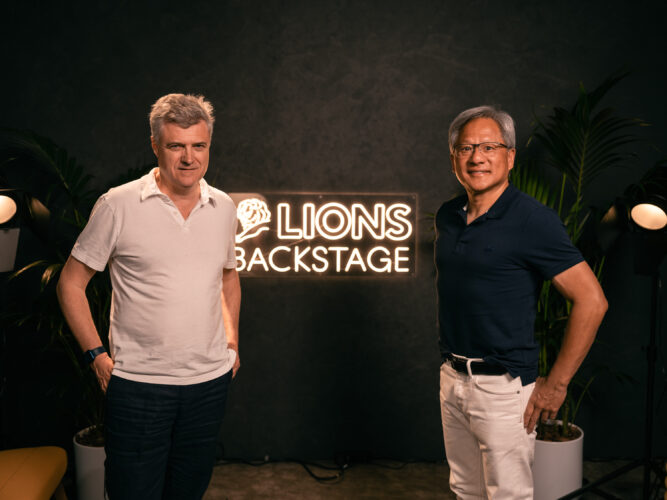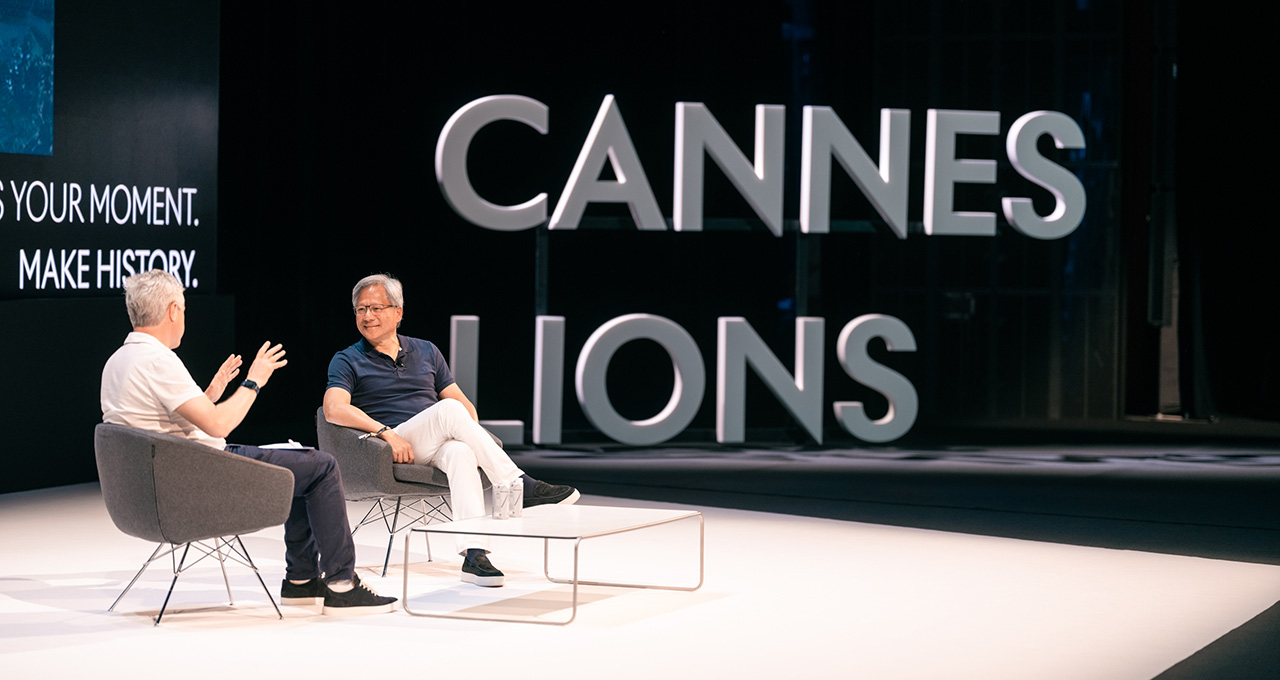Generative AI will “supercharge” creators across industries and content types, NVIDIA founder and CEO Jensen Huang said today at the Cannes Lions Festival, on the French Riviera.
“For the very first time, the creative process can be amplified in content generation, and the content generation could be in any modality — it could be text, images, 3D, videos,” Huang said in a conversation with Mark Read, CEO of WPP — the world’s largest marketing and communications services company.

At the event attended by thousands of creators, marketers and brand execs from around the world, Huang outlined the impact of AI on the $700 billion digital advertising industry. He also touched on the ways AI can enhance creators’ abilities, as well as the importance of responsible AI development.
“You can do content generation at scale, but infinite content doesn’t imply infinite creativity,” he said. “Through our thoughts, we have to direct this AI to generate content that has to be aligned to your values and your brand tone.”
The discussion followed Huang’s recent keynote at COMPUTEX, where NVIDIA and WPP announced a collaboration to develop a content engine powered by generative AI and the NVIDIA Omniverse platform for building and operating metaverse applications.
Driving Forces of the Generative AI Era
NVIDIA has been pushing the boundaries of graphics technology for 30 years and been at the forefront of the AI revolution for a decade. This combination of expertise in graphics and AI uniquely positions the company to enable the new era of generative AI applications.
Huang said that “the biggest moment of modern AI” can be traced back to an academic contest in 2012, when a team of University of Toronto researchers led by Alex Krizhevsky showed that NVIDIA GPUs could train an AI model that recognized objects better than any computer vision algorithm that came before it.
Since then, developers have taught neural networks to recognize images, videos, speech, protein structures, physics and more.
“You could learn the language of almost anything,” Huang said. “Once you learn the language, you can apply the language — and the application of language is generation.”
Generative AI models can create text, pixels, 3D objects and realistic motion, giving professionals superpowers to more quickly bring their ideas to life. Like a creative director working with a team of artists, users can direct AI models with prompts, and fine-tune the output to align with their vision.
“You have to give the machine feedback like the best creative director,” Read said.
These tools aren’t a replacement for human creativity, Huang emphasized. They augment the skills of artists and marketing professionals to help them feed demand from clients by producing content more quickly and in multiple forms tailored to different audiences.
“We will democratize content generation,” Huang said.
Reimagining How We Live, Work and Create With AI
Generative AI’s key benefit for the creative industry is its ability to scale up content generation, rapidly generating options for text and visuals that can be used in advertising, marketing and film.
“In the old days, you’d create hundreds of different ad options that are retrieved based on the medium,” Huang said. “In the future, you won’t retrieve — you’ll generate billions of different ads. But every single one of them has to be tone appropriate, has to be brand perfect.”
For use by professional creators, these AI tools must also produce high-quality visuals that meet or exceed the standard of content captured through traditional methods.
It all starts with a digital twin, a true-to-reality simulation of a real-world physical asset. The NVIDIA Omniverse platform enables the creation of stunning, photorealistic visuals that accurately represent physics and materials — whether for images, videos, 3D objects or immersive virtual worlds.
“Omniverse is a virtual world,” Huang said. “We created a virtual world where AI could learn how to create an AI that’s physically based and grounded by physics.”
“This virtual world has the ability to ingest assets and content that’s created by any tool, because we have this interface called USD,” he said, referring to the Universal Scene Description framework for collaborating in 3D. With it, artists and designers can combine assets developed using popular tools from companies like Adobe and Autodesk with virtual worlds developed using generative AI.
NVIDIA Picasso, a foundry for custom generative AI models for visual design unveiled earlier this year, also supports best-in-class image, video and 3D generative AI capabilities developed in collaboration with partners including Adobe, Getty Images and Shutterstock.
“We created a platform that makes it possible for our partners to train from data that was licensed properly from, for example, Getty, Shutterstock, Adobe,” Huang said. “They’re respectful of the content owners. The training data comes from that source, and whatever economic benefits come from that could accrete back to the creators.”
Like any groundbreaking technology, it’s critical that AI is developed and deployed thoughtfully, Read and Huang said. Technology to watermark AI-generated assets and to detect whether a digital asset was modified or counterfeited will support these goals.
“We have to put as much energy into the capabilities of AI as we do the safety of AI,” Huang said. “In the world of advertising, safety is brand alignment, brand integrity, appropriate tone and truth.”
Collaborating on Content Engine for Digital Advertising
As a leader in digital advertising, WPP is embracing AI as a tool to boost creativity and personalization, helping creators across the industry craft compelling messages that reach the right consumer.
“From the creative process to the customer, there’s going to have to be ad agencies in the middle that understand the technology,” Huang said. “That entire process in the middle requires humans in the loop. You have to understand the voice of the brand you’re trying to represent.”
Using Omniverse Cloud, WPP’s creative professionals can build physically accurate digital twins of products using a brand’s specific product-design data. This real-world data can be combined with AI-generated objects and digital environments — licensed through partners such as Adobe and Getty Images — to create virtual sets for marketing content.
“WPP is going to unquestionably become an AI company,” Huang said. “You’ll create an AI factory where the input is creativity, thoughts and prompts, and what comes out of it is content.”
Enhanced by responsibly trained, NVIDIA-accelerated generative AI, this content engine will boost creative teams’ speed and efficiency, helping them quickly render brand-accurate advertising content at scale.
“The type of content you’ll be able to help your clients generate will be practically infinite,” Huang said. “From the days of hundreds of examples of content that you create for a particular brand or for a particular campaign, it’s going to eventually become billions of generated content for every individual.”
Learn more about NVIDIA’s collaboration with WPP.
